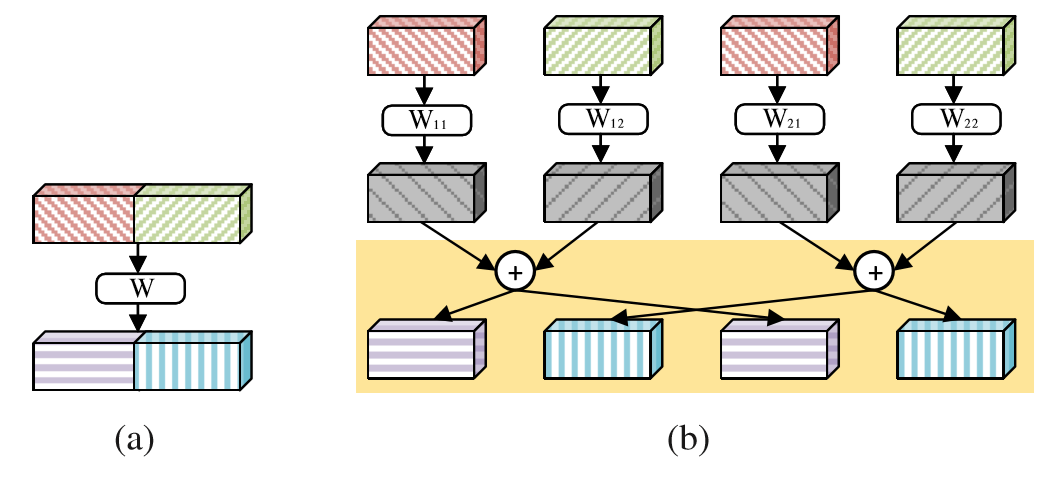This project contains the code implementation used for the experiments in the paper:
Interleaved Group Convolutions. Ting Zhang, Guo-Jun Qi, Bin Xiao, and Jingdong Wang. In International Conference on Computer Vision (ICCV), 2017. arXiv preprint arXIV:1707.02725 (2017)
In this work, we present a simple and modularized neural network architecture, named interleaved group convolutional neural networks (IGCNets). The main point lies in a novel building block, a pair of two successive interleaved group convolutions: primary group convolution and secondary group convolution. The two group convolutions are complementary.
Illustrating the interleaved group convolution, with L = 2 primary partitions and M = 3 secondary partitions. The convolution for each primary partition in primary group convolution is spatial. The convolution for each secondary partition in secondary group convolution is point-wise (1 × 1).
Our motivation comes from the four branch presentation of regular convolution illustrated in the following picture.
(a) Regular convolution. (b) Four-branch representation of the regular convolution. The shaded part in (b), we call crosssummation, is equivalent to a three-step transformation: permutation, secondary group convolution, and permutation back.
| #Params (M) | FLOPs (10^9) | training error | test error | |||
|---|---|---|---|---|---|---|
| top-1 | top-5 | top-1 | top-5 | |||
| ResNet(C=64) | 11.151 | 1.8 | 22.41 | 6.53 | 31.06 | 11.38 |
| ResNet(C=69) | 11.333 | 2.1 | 21.43 | 5.96 | 30.58 | 10.77 |
| IGC-L4M32+Ident. | 11.205 | 1.9 | 21.71 | 6.21 | 30.77 | 10.99 |
| IGC-L16M16+Ident. | 11.329 | 2.2 | 19.97 | 5.44 | 29.40 | 10.32 |
| IGC-L100M2+Ident. | 8.61 | 1.3 | 13.93 | 2.75 | 26.95 | 8.92 |
Imagenet classification results of a ResNet of depth 18 and our approach. Both ResNets and our networks contain four stages, and when down-sampling is performed, the channel number is doubled. For ResNets, C is the channel number at the first stage. For our networks except IGC-L100M2+Ident., we double the channel number by doubling M and keeping L unchanged. For IGCL100M2+Ident., we double the channel number by doubling L and keeping M unchanged.
More results can be found in the paper.
-
Install MXNet on a machine (Windows, Linux, and Mac OS) with CUDA GPU and optional cuDNN.
-
Add the code in
src/to MXNetsrc/operator/ -
Build MXNet
-
If you fail to apply the above steps, you can simply use my MXNet repository
Current code supports training IGCNets on Cifar-10, Cifar-100 and SVHN, such as plain, resnet, plain_igc,resnet_igc. All the networks are contained in the network folder.
For example, running the following command can train the plain_igc network on Cifar-10.
python train_model.py --network=plain_igc --depth=38 --gpus=0,1 --primary-partition=24 --secondary-partition=2 --batch-size=64 --data-dir=<dataset location> --dataset=cifar10For example, running the following command can train the resnet_igc_imgnet_d18 network on ImageNet.
python train_imagenet.py --network=resnet_igc_imgnet_d18 --depth=18 --gpus=0,1,2,3,4,5,6,7 --primary-partition=100 --batch-size=256 --data-dir=<dataset location>Please cite our papers in your publications if it helps your research:
@article{WangWZZ16,
author = {Jingdong Wang and
Zhen Wei and
Ting Zhang and
Wenjun Zeng},
title = {Deeply-Fused Nets},
journal = {CoRR},
volume = {abs/1605.07716},
year = {2016},
url = {http://arxiv.org/abs/1605.07716}
}
@article{ZhaoWLTZ16,
author = {Liming Zhao and
Jingdong Wang and
Xi Li and
Zhuowen Tu and
Wenjun Zeng},
title = {On the Connection of Deep Fusion to Ensembling},
journal = {CoRR},
volume = {abs/1611.07718},
year = {2016},
url = {http://arxiv.org/abs/1611.07718}
}
@article{DBLP:journals/corr/ZhangQ0W17,
author = {Ting Zhang and
Guo{-}Jun Qi and
Bin Xiao and
Jingdong Wang},
title = {Interleaved Group Convolutions for Deep Neural Networks},
journal = {CoRR},
volume = {abs/1707.02725},
year = {2017},
url = {http://arxiv.org/abs/1707.02725}
}

